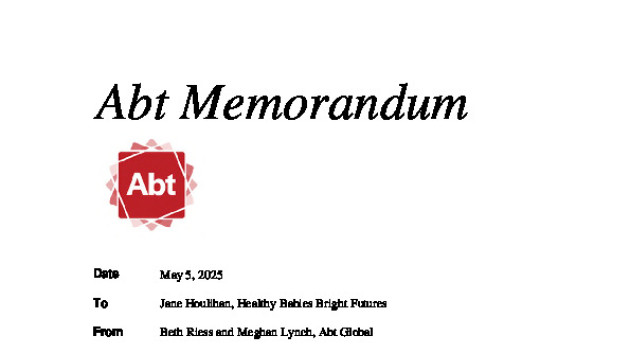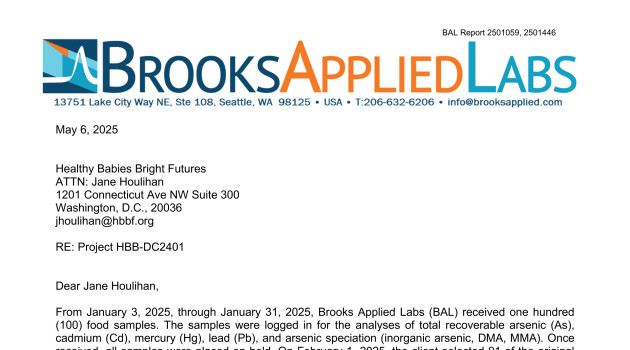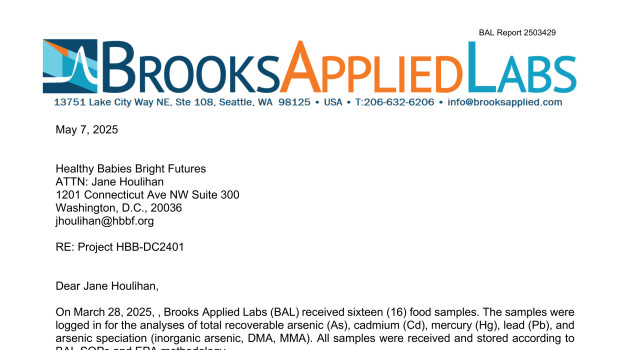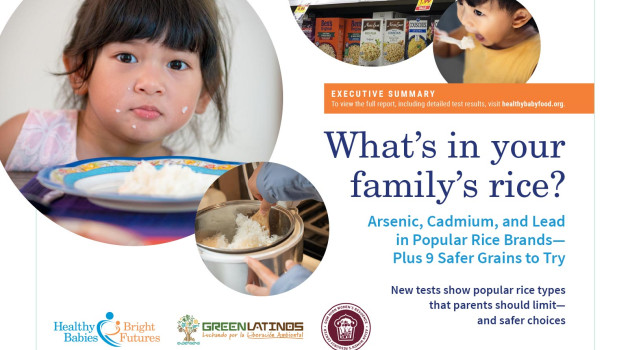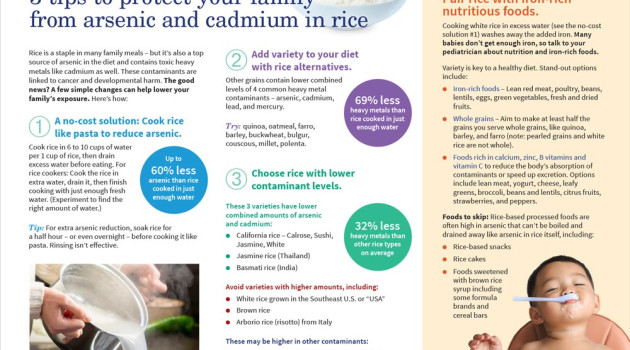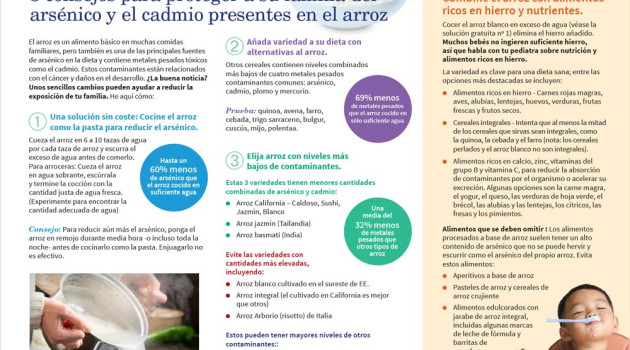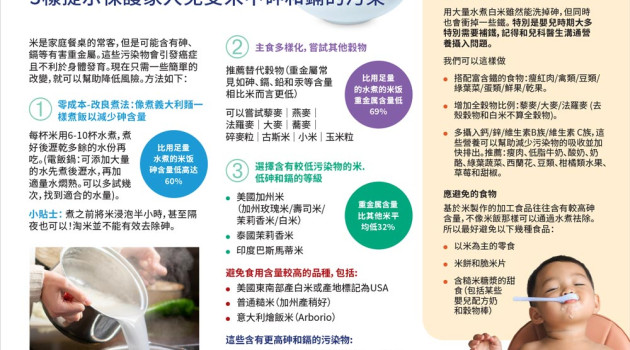
Report: What’s in Your Family’s Rice?

New tests show popular rice types that parents should limit – and safer choices.
What it means for families: Rice is the leading source of arsenic from solid foods in young children’s diets, and a key concern during pregnancy, when developing brains are most vulnerable. The risks are greatest for Asian, Latino, and Hispanic families, who often eat more rice than others.
What parents can do: Simple changes, such as using safer cooking methods, incorporating alternative grains, and opting for lower-arsenic rice varieties, can make a big difference in lowering exposures.
What the FDA can do: Three FDA actions could deliver powerful benefits for families: Setting limits (action levels) for arsenic and cadmium in rice; Encouraging labels on rice products that meet the infant rice cereal standard; Requiring testing and public posting of results.
Report: What’s in Your Family’s Rice?
Executive Summary: What’s in Your Family’s Rice?
What Parents Can Do
Parents play a crucial role in protecting children from the harm of heavy metal contaminants. Our parent tip sheet – available in English, Spanish, and Chinese – outlines three simple changes families can make to help reduce arsenic and cadmium in rice by up to 69%.
Key Findings
Tests of 145 rice samples from retailers nationwide – including U.S.-grown and imported varieties – reveal that rice sold in the U.S. remains widely contaminated with arsenic. Testing commissioned by HBBF detected arsenic in 100% of samples, with more than one-fourth exceeding the federal limit set for infant rice cereal. No such limit exists for the bags and boxes of rice served at family meals,despite it being widely consumed by infants and toddlers. Additionally, cadmium was found in all but one sample, with some showing elevated levels.
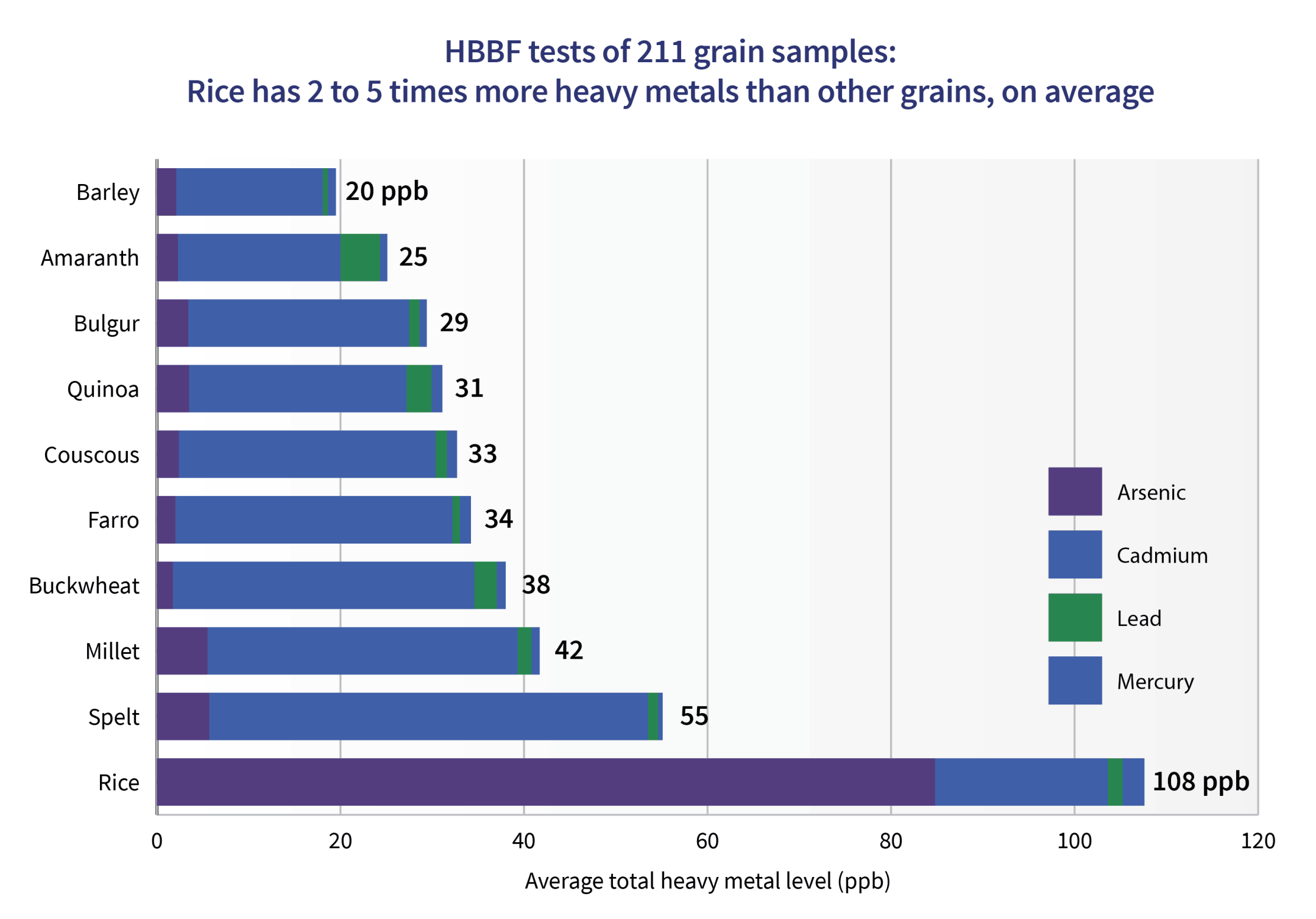
The contaminants are associated with increased risk of cancer, neurological harm during early development, including IQ loss, and other health concerns (EPA 2025a, Hoffman 2024). Despite the potential risks, there has been no significant progress to reduce the amounts found in rice sold in the U.S.
For children up to age 2, rice – not infant rice cereal – is the leading source of arsenic exposure from solid foods. Rice is also a major concern during pregnancy, the most critical window for brain development.
7 Key Insights from Our Report
- Heavy metals were found in every brand of rice tested, but some rice types had far lower levels than others.
- Alternative grains, such as quinoa, couscous, and barley, have significantly lower total heavy metal contamination than rice.
- Precooked rice is convenient, but comes with potential risks from an unusually toxic form of arsenic.
- Many rice brands exceed federal and state health benchmarks for heavy metals.
- Every rice sample tested by HBBF contained toxic heavy metal residues, but certain rice samples stood out with significantly elevated concentrations, including surprisingly high lead levels in seasoned rice.
- Change is vital for Asian, Latino, and Hispanic families, who eat rice more often than other families.
- There is no evidence of industry or FDA progress to reduce arsenic levels in rice.

Parents shouldn’t have to worry that a common first food like rice could carry hidden risks. This study is a wake-up call – but it’s also full of hope. With just a few changes in the kitchen and stronger rules from the FDA, we can dramatically lower children's exposure to harmful metals.
—Jane Houlihan, study author and HBBF’s National Director of Science and Health
Rice Substitutes: Recipes and Cooking Tips
Quinoa has a mild flavor similar to brown rice. It absorbs flavors while cooking, making it easy to customize to your tastes. It can be prepared on the stovetop in about 15 minutes.
Compared to rice: 71% less heavy metals, 7 times more expensive per serving.
Recipe Ideas:
Oats are a cereal grain, from the edible seed of oat grass. Oats come in many textures based on how they are processed, e.g., steel-cut or Irish, Scottish, rolled or old-fashioned, quick or instant. Cooking times vary based on the oat type, ranging from 20 to 30 minutes or more for steel-cut or Irish oats to just a few minutes for instant oats.
HBBF’s tests of oatmeal find heavy metals levels that are significantly lower than those in rice (HBBF 2019, 2022)
Recipe Ideas:
Farro has a nutty flavor and satisfying chewy texture. It is cooked in boiling water like pasta, until tender. It can also be prepared in a rice cooker. Cooking times vary by farro type (i.e., pearled, semi-pearled, and whole), ranging from 15 minutes for pearled to 40 minutes for whole.
Compared to rice: 68% less heavy metals, 5 times more expensive per serving.
Recipe Ideas:
- Cilantro lime farro (like Chitpotle’s cilantro lime rice)
- Farro fried rice
Barley is a hearty, chewy grain commonly used in soups, stews, salads, and grain bowls. Cooks on the stovetop in about 20-50 minutes depending on whether you opt for the quicker pearl variety, or hulled.
Compared to rice: 82% less heavy metals, 3 times more expensive per serving.
Recipes to try:
Buckwheat’s small, nugget-type granules can be used in the same way as rice. You can also find buckwheat as flour, noodles or even flakes. It is a convenient substitute for wheat flour. Cooks on the stovetop like rice, requiring 18 to 20 minutes of cooking time.
Compared to rice: 65% less heavy metals, 5 times more expensive per serving.
Recipes to try:
This nutty, chewy and earthy grain is made of cracked, debranned, partially cooked (parboiled) wheat. It’s usually ready within 12 to 25 minutes on the stovetop, depending on the coarseness. Coarse bulgur wheat can typically be used in any recipe that calls for brown rice – they’re similar in taste and texture.
Compared to rice: 73% less heavy metals, 4 times more expensive per serving.
Recipes to try:
